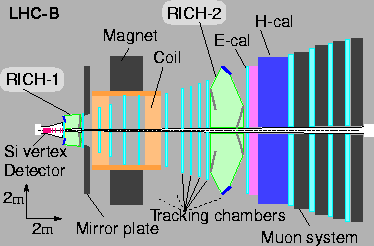 |
RICH detectors meet the experimental criteria
for particle identification in
the required momentum range.
It is proposed to use two
RICH detectors in the LHC-B experiment, see fig 1.
The upstream detector (RICH1), fig. 2,
has a combined gas and aerogel radiator and is situated in
front of the dipole magnet. The aerogel radiator is placed against the
entrance window of the second gaseous (
C4F10) radiator.
A spherical mirror with a radius of curvature of 190 cm is tilted by
![]() 250 mrad to reflect the Cherenkov light onto an array of photodetectors
situated outside the experimental acceptance. The downstream RICH
(RICH2), fig. 2, uses CF4 as its radiator with a spherical
mirror with a radius of curvature of 820 cm tilted by 370 mrad. An
additional flat mirror is tilted by 240 mrad to bring the
Cherenkov photons out of the acceptance of the experiment.
250 mrad to reflect the Cherenkov light onto an array of photodetectors
situated outside the experimental acceptance. The downstream RICH
(RICH2), fig. 2, uses CF4 as its radiator with a spherical
mirror with a radius of curvature of 820 cm tilted by 370 mrad. An
additional flat mirror is tilted by 240 mrad to bring the
Cherenkov photons out of the acceptance of the experiment.
Each RICH detector has two photodetector planes giving a total area of 2.9 m2. The chosen detector technology must have a high quantum efficiency, a spatial resolution of at least 2.5 x 2.5I>mm2 and to have a fast readout consistent with 25 ns bunch crossing of the LHC. Two candidate technologies exists [3]: hybrid photodiodes (HPDs) and multianode photomultipliers. These detectors are commercially available but not in designs that meet the experimental needs of LHC-B. A program of R&D is currently underway on the development of a HPD with a large active area.